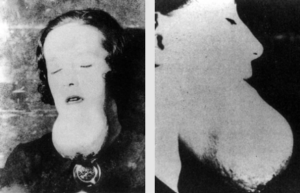Winner of the Fall 2017 StMU History Media Award for
Best Article in the Category of “Crime”
Think back to the first horror movie you ever watched. Was it Halloween? Nightmare on Elm Street? Friday the 13th? Think about what all these movies have in common. If you guessed death, then you’re right. Most people will say they love a good horror film because of the rush of adrenaline; others will say they love the absurdity. Regardless of the reason, there is still a love for all things horror.

But, where does this culture come from? While there are some people that love fictional horror, there are those that love real-life horror. These men and women idolize and fantasize about serial killers and murderers. They study all the crime reports, watch every documentary, and read every biography or narration of a killer’s life. Why is it that men and women like Richard Ramirez, self proclaimed satanist and vicious murderer, become celebrities through their killing? Serial killers sometimes gain groupies and copy-cat killers. Ramirez is one of many examples of distorted stardom but, his story gives us an image of America’s culture of death and our obsession with serial killers.
There are countless examples of killers being studied and filmed for the purpose of entertainment. Serial killers like Ted Bundy and Jeffrey Dahmer have had numerous documentaries appear, studying and depicting their lives. Books like The Stranger Beside Me and Zodiac have made millions in simple narration of the investigations or the killings themselves. Even Ramirez has had his name in Hollywood several times. He was depicted in one episode of the 2015 season of American Horror Story, and in 2016, Lou Diamond Phillips portrayed Ramirez in a dramatization of his life in A&E’s The Night Stalker.1 A Google search of his name will turn up thousands of articles and blogs detailing his life and killings. On YouTube, there are hundreds of videos from Ramirez’s trial along with subsequent interviews. Scrolling through the comment section, there are varying opinions on Ramirez. Some call him charming and philosophical, others say he is cocky and Charles Mansonesque.
Then, you will find men and women who find Ramirez attractive. This psychological phenomenon is known as hybristophilia, a type of paraphilia where a person is sexually attracted to and aroused by a person who has committed a vicious or gruesome crime.2 While Ramirez was still alive and in prison, hundreds of women would line up to try and visit him. At one point there were so many women in line, that more than half had to be turned away. Ramirez himself ended up marrying one of his “fans” while in prison. This woman was Doreen Lioy, a forty-one year old freelance editor. They were married on October 3, 1996 and remained husband and wife for twelve years before Ramirez died of B-cell lymphoma at the age of fifty-three.3

While she was the only woman to have married Ramirez, she was not the only woman “in love” with him. From the time of his arrest to his death, there were hundreds of “women in black” who wrote him letters in jail and went to every court hearing of his. Below is a news segment featuring two of Ramirez’s deluded fans.
https://www.youtube.com/watch?v=-Rlm-n3vfVM
To the average person, a serial killer is not a person, but a monster incapable of giving or receiving love. Very few would look into the eyes of a murderer and feel overcome with affection. But, in the 1980s and 1990s when Ramirez’s trial was all over the news, Americans couldn’t get enough of him. And so, the rise of serial killer notoriety comes to a peak, with an all-time high of serial killer reporting taking place and law enforcement spending more time and funding trying to understand serial killer psychology and motivation. Thus the culture of death was born.4
That is not to say that serial killers or murderers have not existed in history previously. They have, but there was not nearly as much attention given to them. The mid-twentieth century saw a worldwide increase in serial killers and mass murderers. This phenomenon has been documented all the way through the twentieth century, with a high concentration of killers and murders in the United States. Interestingly enough, there has been no evidence to show a slowing point to this killer influx. The rate of murder and killing has exponentially grown through the twentieth- and into twenty-first century. Because of this, there is an increase of study and focus being put onto these killers and atrocities. Many scholars and public health practitioners have devoted their time to researching and interviewing these killers in hope of understanding their motives for committing such heinous crimes.5
Though, with all this research, the primary focus is always put on the killer and their survivors, if any are left. In situations of a serial killer being found and arrested, public health officials will spend time talking about the crimes committed and their political and social ramifications. And, while they investigate and interview those who knew the killer, sometimes a motive is never found, leaving the community to deal with the loss of life in a shroud of mystery and anguish.6

So, with all the time and resources devoted to understanding and predicting psychotic behavior, there has been no major breakthrough. Most of this difficulty comes from how “normal” these killers and murderers look. They could be friends, co-workers, or even family members—they blend in.7 Take for example The Stranger Beside Me, written by Anne Rule. She wrote about her experiences with Ted Bundy and described how she was completely shocked by the atrocious crimes he committed. But, before his arrest, he was a master of disguise and incredibly charming; there’s no way a man like that could be a cold-blooded killer. Right?
When speaking about Richard Ramirez, there was no surprise that he was troubled. As a child, he was diagnosed with epilepsy and grew up under the influence of his older cousin Mike. His older cousin was a Vietnam veteran who taught Ramirez to kill and smoke weed. As Ramirez grew older he began stealing to pay for a growing drug addiction; during this time, he also began to see himself as a child of Satan. As he grew, he became more troubled, working at a hotel and then being fired for trying to rape a woman in her room. He was sixteen at that time, though Ramirez was not found guilty because the Judge felt he had been lured into sex rather than the one to force it.8
After dropping out of high school, Ramirez, at the age of eighteen, moved to California and became a full time criminal. As his addiction to drugs grew, so did the violence of his crimes, resulting in a deadly cocktail of rage and addiction. All of this came to a climax in June of 1984, and after brutally murdering his first victim, seventy-nine year old Jennie Vincow, he went on a year-long killing spree.9 The wake of destruction he left after every break-in and murder left the nation in shock and terror. After every rape and murder he committed, a pentagram could be found either on the body of his victim, or somewhere in the crime scene, and this became Ramirez’s signature.10
He was finally apprehended on August 31, 1985 after his last victim was able to look out the window, and see the stolen car he was driving and a portion of the license plate. When Ramirez was found, he was in an East L.A. neighborhood, and police officers had to stop residents from beating him to death.11 But, during his trial there was no clear motive found. The disturbing conclusion was that Ramirez killed people and raped women because he liked it. And so, there comes a battle between sympathizing with Ramirez because of his traumatic and turbulent childhood, and condemning him as a “Satan-obsessed serial killer who enjoyed every murder and rape he committed.”12
The media had a large influence on this tug of war. From the first murder he committed to his very last day in court there was no shortage of stories. The more stories printed about “The Night Stalker,” the more the public wanted. News outlets focused on his surviving victims and the gruesome details of his crimes. News had begun to focus on the spectacle of things. Newspapers depicted his crimes as atrocities and disasters to the L.A. and San Francisco area, and every story of his made the front page. As Mary Ann Doane, a commentator on mass media, said “Catastrophe is at some level always about the body, about the encounter with death.”13
So, as a society we became obsessed with death. Even now, thirty-two years after Ramirez’s arrest and four years after his death, we still watch his documentaries, we still read the biographies, we still find him disturbingly fascinating. Richard Ramirez still has our attention.
- “Richard Ramirez Biography,” biography.com, last modified October 13, 2017, https://www.biography.com/people/richard-ramirez-12385163. ↵
- James Alan Fox, “Lovesick over Charles Manson. Really?,” USA Today, (2014): 08a, 6 October 2017. ↵
- “Richard Ramirez Biography,” biography.com, last modified October 13, 2017, https://www.biography.com/people/richard-ramirez-12385163. ↵
- Judith S. Baughman, Victor Bondi, Richard Layman, Tandy McConnell, Vincent Tompkins, eds., “Serial Killers and Mass Murderers,” in American Decades Vol. 9, 1980-1989, (Detroit: Gale, 2001). ↵
- D. L. Peck and R. B. Jenkot, “Serial and Mass Murderers,” in International Encyclopedia of Public Health Vol. 5, 690-691 (Oxford: Academic Press, 2008). ↵
- D. L. Peck and R. B. Jenkot, “Serial and Mass Murderers,” in International Encyclopedia of Public Health Vol. 5, 690-691 (Oxford: Academic Press, 2008). ↵
- Jarlath Killeen, “The Monster Club: Monstrosity, Catholicism and Revising the (1641) Rising,” in The Emergence of Irish Gothic Fiction: History, Origins, Theories 2014, ( Scotland: Edinburgh University Press, 2014), 5. ↵
- J. Gordon Melton, “Ramirez, Richard (1960-),” in Encyclopedia of Occultism and Parapsychology, (Detroit: Gale, 2001), 1279. ↵
- “Richard Ramirez Biography,” biography.com, last modified October 13, 2017, https://www.biography.com/people/richard-ramirez-12385163. ↵
- J. Gordon Melton, “Ramirez, Richard (1960-),” in Encyclopedia of Occultism and Parapsychology, (Detroit: Gale, 2001), 1279. ↵
- “Richard Ramirez Biography,” biography.com, last modified October 13, 2017, https://www.biography.com/people/richard-ramirez-12385163. ↵
- Jarlath Killeen, “The Monster Club: Monstrosity, Catholicism and Revising the (1641) Rising,” in The Emergence of Irish Gothic Fiction: History, Origins, Theories 2014 ( Scotland: Edinburgh University Press, 2014), 5. ↵
- Mark Seltzer, “Serial Killers (11): The Pathological Public Sphere,” Critical Inquiry 22, no. 1 (1995): 131. ↵



109 comments
Charli Delmonico
This article was incredibly well-written and held my attention the entire time. I read another article on this website about this killer, but I didn’t realize how famous he was in the US and how much women loved the fact that he was a gruesome, brutal person. I still can’t believe how traumatic his childhood was, but that is no excuse to kill people and rape women. I also thought it was a little weird that Ramirez got married while in jail and remained married until he died.
Kathryn Martinez
This article is an another example of how people can try to justify the horrors that these serial killers commit. These are real people who have gone out of their way to kill people, to end a human being’s time on earth. The fact that people are willing to marry these serial killers after the fact of conviction just goes to show that the human mind is unpredictable. Or even to the fact that there are people that are part of these “fan clubs”.
Priscilla Poorbaugh
I feel like people give serial killers so much attention because they are honestly fascinating. Like how are they able to kill with no remorse? What’s going on in their head? As to people falling in love with them, there must be something wrong in their head as well. It is also always interesting to learn about what happened in a serial killers past that lead them to be the way that they are, because almost all of them have some sort of messed up childhood.
Patricia Arechiga
It is highly upsetting how it is often the most wicked individuals who receive the most attention and obsession from both the media and society. It’s not the first time a serial killer ends up marrying a fan. Take a look at Ted Bundy. The sad part, though, is that most serial killers / criminals, thrive from the attention. It is crazy the amount of power looks and charm can have on people. It is often those we least expect that sustain the darkest of secrets. However, at the same time, it is interesting to see how criminals work, though. Leaving behind ‘signature’ prints after their killings to provide a path for officers to follow is surly something a normal person wouldn’t do. Though his killings were beyond unforgivable, knowing he had mental issues yet received no help is no shocker. It’s sad to see the amount of people with mental issues who get no help yet we are ‘surprised’ when they commit crimes.
Brianna Nevarez
I have heard about countless obsessions but being in love with a rapist and murderer? That is disgusting and insane. I do not know how women could possibly be attracted to a monster. The fact that this man had ‘fans’ while in prison and they would visit him and one even got married to him, it is a bit concerning. I am appalled. This murderer and rapist deserves no recognition, I am sure he fed off the attention he was given. I am shocked that he raped and murdered women just because ‘he liked it’.
Diego Terrazas
It is disturbing that a serial killer got this kind of attention. It was obvious Ramirez liked the attention and even saw himself as a celebrity which is rather sociopath behavior, yet society romanticized him. Physical attractiveness may get you out of many troubles but murder should not be on of them. I strongly believe we should deprive such characters of attention.
Samantha Ruvalcaba
I’m glad you mentioned the term for it, hybristophilia, because I have seen this sort of things in the documentary varies I watch about serious killers and never know the word for it. I find it so interesting and cringeworthy that these women have these types of attractions. Society’s curiosity towards crime is one thing, but romanticizing the culprits is something else entirely.
Tala Owens
I have never heard of Ramirez before this and I think it’s crazy how he had “fans” and people lining up to see in jail knowing about the crimes he committed. It does sound kind of sick to still find someone attractive and so much so that you would go visit them in jail even though you know they have raped and killed several innocent women. I can see why someone would find serial killers “disturbingly interesting” but developing crushed on them or marrying them seems like too much and very disrespectful to the victims.
Leeza Cordova
This article was beautifully written and kept me attentive the whole entire time. I thought it was interesting to see the idea of crime from another lense and ponder about my personal feelings with crime and why I personally like it. I have often seen cases like Ramirez and wonder why women become fantized with these killers, maybe because of looks or the idea of having a bad boy. Overall, I think that society has increase the stigma for killers, due to the fact of movies and more awareness of them with documentaries.
Oscar Ortega
This is a very well-constructed article that does raise an interesting set of questions: why are we so fascinated with the gruesome, the macabre, and the disturbing? Why do we find it so necessary to analyze and dissect the minds of those who commit atrocities, thoughtlessly or otherwise? Why do we devote so much time, energy, and attention to people who do some of the worst things? Why do some people idolize killers, even when they know that As is mentioned in this article, there is no good answer. Morality, humanity, good and evil are all as unique to us as handprints, and for some reason or another sometimes it’s as easy to find sympathy as it is to condemn someone, no matter which is which and if they’re done for the right reasons. Perhaps the answer lies in the question. We try so hard to know, to understand, because the thought of a question even exists. This article does a fantastic job of intercutting a strong story with relevant information and a provocative question. Excellent work.